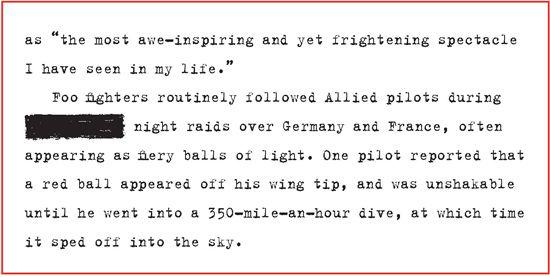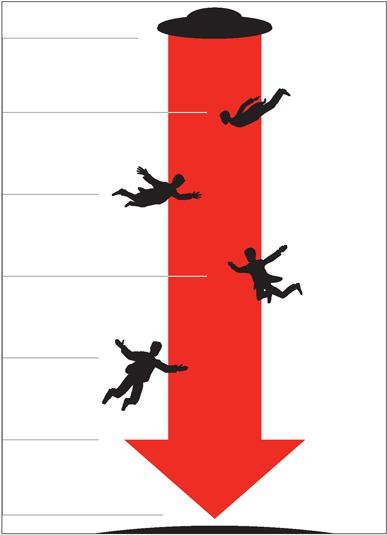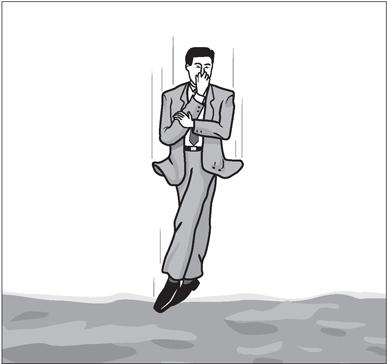The Alien Invasion Survival Handbook: A Defense Manual for the Coming Extraterrestrial Apocalypse (14 page)
Authors: W. H. Mumfrey
Tags: #ebook, #epub


Extreme escapes are a last resort. All other means of evasion should be attempted first.
How to Survive a Freefall Skydive After Being Jettisoned at 20,000 Feet
First and foremost, think positively. Although survival is improbable, it is not entirely impossible. At least three military airmen have survived falls from over 15,000 feet without parachutes. Nick Alkemade was a tail gunner in a British Lancaster bomber during World War II. While returning from a mission over occupied Europe on March 23, 1944, his plane was hit by enemy gunfire. As the plane started to spiral out of control and Alkemade was unable to reach his parachute, he decided to leap from the plane rather than burn to death in the wreckage. He fell more than 18,000 feet before hitting the ground. Trees in a pine forest broke his fall before he landed in soft snow. He sustained only minor injuries, including a sprained ankle, and was able to walk away from the scene.

FIGURE 3.1:
Utilize freefall maneuvers to reduce your air speed.
In addition to arming yourself with the assurance that survival is possible, you would do well to remember the following guidelines.
WARNING
Free jumping is a high-risk activity and should not be attempted unless in the most life-threatening circumstances. All other alternatives should be considered before jumping. This is not a procedure that can or should be practiced at home.
1. DON'T PANIC.
As always, it is imperative that you remain focused and attentive for the three minutes it will take you to reach the ground. Upon exit from the spacecraft, search the terrain below for suitable landing sites.
2. UTILIZE FREEFALL MANEUVERS.
It is vitally important that you reduce your air speed as much as possible. This can be achieved by adopting the stable “face to Earth” position. Spread your arms and legs. A falling body reaches a maximum speed, or terminal velocity, of around 120–140 miles per hour. This speed is reached after falling just 1,000 feet. So a fall from 20,000 feet makes no difference to your final impact speed.
3. SELECT A SUITABLE LANDING SITE.
This is the key to your survival. The best drop zone will be over a forest, a swamp, snow, or any terrain that can absorb at least some of the impact. Avoid urban areas, exposed hillsides, and agricultural land. Make any in-flight course corrections by shifting your body weight or adjusting the positions of your arms and legs.
4. ADOPT A LANDING POSITION.
Keep your body upright and relaxed. Bend your knees slightly and point your toes in the direction of the proposed landing site. Arch your hips in the direction of the proposed roll. Tuck your arms tightly around your head.
5. LAND AS SMOOTHLY AS POSSIBLE.
It is important to remember that it's not the 20,000-foot fall that kills you; it's the sudden stop at the end. Contact with the ground should be performed in a single, continuous motion so that the shock is not focused on any one part of the body. Initial contact should be made with the feet, then rolling on one side, the calf, followed by the thigh, buttocks, then diagonally across the back. Remember to keep your head tucked down and your feet and legs together as you roll. Do not use your arms to break your fall; they must protect your head.
6. ASSES ANY DAMAGE AND RUN FOR COVER.
It is highly likely that you will sustain significant injuries upon impact. This, however, should not deter you from seeking immediate cover. Aliens have been known to scour an area for hours looking for escapees. There is no guarantee that concealment will be successful, but at least you don't want to make things easy for them.
How to Survive a Jump From a Low-Flying Spacecraft Into Water
You are onboard an alien spacecraft and have just overpowered your captors. You run down a dimly lit corridor when there is a sudden rush of cold air behind you. Turning around, you see a floor panel sliding open. Looking through it, you see water rushing past, some 150 feet below. Hearing footsteps coming up the corridor, you decide to take your chances and jump through the hatch. You're as good as free … if you remember these instructions.
1. QUICKLY SCAN THE HORIZON.
Avoid the urge to close your eyes. You can accelerate to more than 60 miles per hour in less than four seconds, so you have very little time to prepare for impact. Quickly look around and locate the closest land mass. You will need to swim there after hitting the water.
2. POSITION YOUR BODY FEET DOWN.
Hold your legs straight, crossing them at the ankles. Your legs must be firmly clasped together to avoid impact trauma to your genitalia.
3. HOLD YOUR NOSE.
To avoid the possibility of a “nasal enema,” hold your nose firmly with one hand. Tuck your arm firmly against your body. Use your other hand to hold your first arm tightly in place.

WARNING
Freefall diving is a high-risk activity and should not be attempted unless in the most life-threatening circumstances. All other alternatives should be considered before jumping. The diver must have perfect concentration and timing to enter the water in the correct position. The body is exposed to enormous deceleration forces on impact, and all but the trained athlete will have little chance of survival. If the gods smile upon you and you do survive the impact, then you only have to worry about hypothermia, ocean currents, sharks or crocodiles, exhaustion, and drowning before reaching shore.
4. FACE FORWARD.
Tense your neck muscles so that you're looking straight ahead. Make yourself as streamlined as possible by keeping your body straight.
5. ENTER THE WATER FEET FIRST.
Entering the water in any other position from this height without extensive training could result in serious injuries or death.
6. SPREAD OUT YOUR ARMS AND LEGS.
Once your body has entered the water, spread your arms and legs out to stop yourself from going any deeper. Having plunged into the water at more than 60 miles per hour, you will probably be about 10 feet under the surface. If you find yourself disoriented, follow the bubbles as they ascend to the surface.
7. SWIM TO SHORE.
After reaching the surface of the water, turn in the direction of land and begin swimming for shore.
8. SEEK SHELTER.
You will need to take evasive action for the next twelve to twenty-four hours. Your alien enemies will undoubtedly be looking for you.
How to Survive in the Vacuum of Space
The likelihood of an unprotected human being surviving in space has been a hot topic for discussion since the 1968 classic science-fiction film
2001: A Space Odyssey
, in which astronaut Dave Bowman “blows” himself from the pod into the airlock without a helmet. How long can a human survive if exposed to the vacuum of space? Would you explode? Would your blood boil? How long would you remain conscious? These are all important questions if you suddenly and unexpectedly find yourself expelled from an alien spacecraft while in orbit.

Although, by its very nature, being alone in the vacuum of space is a frighteningly desperate predicament, there are a number of strategies that will help you regain control of the situation.
1. EXPEL ALL THE AIR FROM YOUR LUNGS PRIOR TO DECOMPRESSION.
It is imperative that you do not hold your breath during decompression. Just as scuba divers must remember to exhale as they ascend from the depths of the ocean, you must do the same prior to decompression. The sudden drop of external pressure will cause any air remaining in your lungs to expand rapidly, resulting in the shredding of the soft tissues in the lungs.
2. CHEW SOME GUM.
Although usually only a minor annoyance when flying in airplanes or driving in the mountains, blocked ears can pose a serious problem in space. Air pressure in your middle ear is usually the same as your outer ear. The Eustachian tube, a narrow channel connecting the middle ear with the throat, opens periodically in response to swallowing or yawning, allowing air to flow into or out of your middle ear, effectively equalizing the pressure. If the Eustachian tube is blocked due to a common cold, allergy attack, or sinus infection, explosive decompression can result in ruptured or perforated eardrums. Chew gum to help keep your Eustachian tube clear; if that doesn't work, try clearing them by gently exhaling while holding your nostrils closed and keeping your mouth shut.
3. DON'T PANIC.
The very thought of perishing within minutes in the cold vacuum of space will cause all but the most stout hearted to tremble. Yet at this time, like no other in your life, you must remain focused on the task at hand and not become distracted by such things as the novelty of zero gravity, the startling clarity of the stars around you, or how you wish you had put on a warm jacket before leaving home. Your actions within the next few seconds will determine whether you live or die.
EXPLOSIVE DECOMPRESSION IN SPACE: FREQUENTLY ASKED QUESTIONS
CAN I SURVIVE?
Yes, if you can fight your way back into the spacecraft within approximately sixty seconds, there is a good chance of survival. Death is guaranteed after two to four minutes.
HOW LONG WILL I REMAIN CONSCIOUS?
From real-life accounts involving decompression in high-altitude aircraft and experimental decompression chambers, it is understood that you will probably have about ten to fifteen seconds of “useful” consciousness. During this time, you will still be able to perform manual tasks with some degree of dexterity. Soon after this, you will lose consciousness due to the lack of oxygen.
